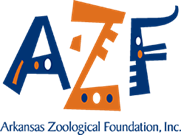Lizards
Blue-Tongue Skink
They are pale brown with a gray underside. Some may be streaked with dark brown or white.
Habitat/Range:
This skink lives in Australia and prefers a habitat of semi-desert, mixed woodlands, and scrubland habitats.
Behavior:
Docile reptiles they tend to be shy and prefer to spend their time hiding in hollow logs or debris. These skinks are known for their brightly colored tongue which serves as a defense mechanism. When threatened they will open their mouths and show their tongue. In the wild, brightly colored animals usually mean danger so the predator will become frightened and not attack.
This reptile can lose it tail in a fight and grow it back.
This species has not been evaluated for the IUCN Red List. They are popular in the pet trade.
Conservation Action:
Australia prohibits commercial exporting of most wildlife, including this species.
Frilled Lizard
Frilled lizards have long limbs and tails. Their tails are grey brown and striped with gray tip. The Frilled lizard’s tongue and mouth are pink or yellow and they have a frill around their neck which they raise when threatened or alarmed. They are sexually dimorphic with males being larger than females.
Habitat/Range:
These lizards are found in northern Australia and southern New Guinea in sub humid to semi-arid grassy woodlands and dry forests.
Size:
Length: 33in. Frill size: 12in. Weight: 0.88-2.3lbs.
These lizards are bipedal and walk on their back legs!
Least Concern. They are harmed by the arrival of the cane toad and seasonal fires, and are highly sought after in the pet trade.
Conservation Action:
They occur in Kakadu National Park. Populations are being monitored to study the impact of aforementioned threats.
Giant Madagascar Day Gecko
These lizards are bright green to blue green with orange-red facial markings. There may be red spots or bars along the tail.
Habitat/Range:
Found in Madagascar, this species is known for its ability to thrive in degraded forests. They prefer large trees and an ample food supply.
Size:
Length: 11in.
- Some species of geckos do not have eyelids. Instead, they have to lick their eyes with their tongue to keep them clean.
- The Geico gecko seems to most likely resemble this species.
IUCN lists as a species of least concern. There are no known major threats. This species is legally exported for the pet trade.
Conservation Action:
They occur in protected forests. Listed under CITES Appendix II.
Gila Monster
Gila monsters are stocky lizards with large heads and fat tails. Their bodies are covered in round, bony scales, which make them “beaded” in appearance. These scales are black, yellow, and pink and form various patterns depending upon the subspecies.
Range/Habitat:
The Gila monster ranges from the extreme southwestern Utah, southern Nevada, and adjacent San Bernadino County, California, southeastward through west and south Arizona and southwestern New Mexico. It can also be found south into Mexico through Sonora to northwestern Sinaloa. Gila monsters inhabit dry areas such as desert scrublands, rocky hillsides, canyon bottomlands, and arroyos (gulches).
Size:
Length: 1.25-2 feet.
- Gila monsters are one of only two venomous lizards in the world. However, this venom is not used to kill prey like a snake might, but as a defensive measure instead.
- Gila monsters can for months go without food. They will rely on fat stored in their tails to sustain them.
- Contrary to popular myth, the Gila monster is unable to jump.
IUCN lists as a near threatened species. It is legally protected in all states where it is found. Gila monsters are often killed due to the fact that they are venomous. They also face threats from habitat loss and fragmentation, predation by feral dogs and cats, and the pet trade.
Conservation Action:
The collection of Gila Monsters is prohibited by law throughout their range. Listed as CITES Appendix II.
Gliding Gecko
They have skin flaps on either side of its body, webbed feet, and a flattened tail which helps it to glide short distances lending to its name. They are camouflaged well and their skin flaps help them to blend into the trees.
Habitat/Range:
This gecko inhabits Southern Thailand and northeastern India, and Malaysian Peninsula. They prefer lowland forests.
Size:
Length: 4in.
A flying gecko? Technically, this gecko can’t fly by flapping its arms and legs. Instead, it glides using flaps of skin, sort of like the flying squirrels that live in the United States. This lizard has flaps of skin off its head, arms, legs, tail and between their toes. All of these flaps increase their surface area, sort of like a parachute, allowing them to glide from branch to branch.
IUCN has not evaluated. They are part of the pet trade.
Green Crested Basilisk
They have long toes on their rear feet with fringes which allows them to walk on water to escape predators. They are also called plumed or double-crested basilisk due to the crests on their head and back. These lizards can live up to 10 years in captivity.
Habitat/Range:
They are found in the tropical rain forests of Central America, from southern Mexico to Panama.
Size:
Length: 2-2.5 feet.
Due to their ability to walk on water these lizards have been given the nickname “the Jesus Christ lizard.”
Least Concern. They are threatened by habitat loss, and are a part of the pet trade (although many in the trade are captive bred).
Conservation Action:
They are found in protected areas.
Green Iguana
The young vary in color from green to brown and can look mottled or banded. As they age they become more consistent in color, however, their coloring is known to change based on their health, mood, temperature, and even social status. They also change color throughout the day to aid in thermoregulation. In the mornings when it is cooler they tend to be darker so that they can absorb more sunlight. Iguanas have a pendulous dewlap under their throat and a dorsal crest of dermal spines that run down the back. Their eyes are protected by an upper immovable eyelid and a lower movable eyelid.
Habitat/Range:
Iguanas live throughout Central and South America and prefer to live high up in the tree canopy. They enjoy being next to bodies of water because they are excellent swimmers and dive under water to hide from predators.
Size:
Length: 6.5 feet. Weight: 9-14lbs.
Iguanas have a parietal eye on their back which serves to regulate solar energy and detect changes in shadows associated with predators.
No special status. However, populations have dropped due to poaching and the pet trade. They are also farmed for food and leather.
Conservation Action:
Listed CITES Appendix II. There are also some captive breeding programs.
Leopard Gecko
They received their name due to their coloration. They are yellow with irregular black spots and white stomach. However, due to the pet trade they can be found in a large variety of colors. They have a segmented tail which they can autotomize, or drop in an emergency. These lizards have movable eyelids with vertical slit pupils. They have clawed toes which help them to climb rocks and branches. Males are usually larger than females.
Habitat/Range:
These lizards can be found in Afghanistan, Iraq, Iran, Northwest India, and Pakistan. They prefer dry and semi-dry desert regions and grasslands.
Size:
Length: 8-10 in.
Due to their auditory structure, when looking at the ear from the side of their head you can see clear to the other side!
Not evaluated. They make popular pets and are believed to be captive bred from Palestinian ancestry.
Prehensile-Tailed Skink
(Solomon Island Skink)
They can get up to two feet in length, and are brownish-green in coloration. They have small eyes and are especially known for their prehensile tail.
Habitat/Range:
This skink is found on the Solomon Islands and prefers forest habitats.
Size:
Weight: 2lbs.
If they lose their tail they are not able to grow a new one.
This species has not been evaluated for the IUCN Red List. They are threatened due to the pet trade and deforestation.
Conservation Action:
Listed on CITES Appendix II.
Red Tegu
Tegus are large lizards with a beaded appearance to their scales. As their name implies, red tegus become red in color as they mature.
Range/Habitat:
Red tegus are found in Argentina and Uruguay. They inhabit grasslands, woodlands and dry semi-deserts.
Size:
Length: 2.5-4 ft.
UCN does not have them listed. Red tegus are popular in the pet trade and hunted for their hide.
Round-Nosed Plated Lizard
They are usually gray/brown in color with head shields that are fused to the skull. All of their scales are keeled, or ridged, giving them their “plated” appearance. They are moderately large lizards with broad tails. Their undersides are lighter in color.
Habitat/Range:
These lizards come from Eastern and Southeastern Africa. They prefer to live in rocky habitats and will wedge themselves between rocks for cover.
Behavior:
Diurnal, they are most active during the day and sleep at night. They live in burrows that they may even share with a mongoose or snake. When threatened, it can lose its tail or expand its body to appear larger.
This species has not been evaluated for the IUCN Red List.
Scheltopusik
Sheltopusiks are tan in color with lighter heads and undersides. Their body appears to be segmented, though this is just due to their ring-like pattern. They have a distinctive fold of skin down each side known as a lateral groove. Though they may look like a snake, they are indeed a lizard.
Range/Habitat:
The sheltopusik, or European legless lizard, can be found in several countries throughout southern Europe through central Asia. They prefer to live in open country such as grasslands and sparsely wooded hills.
Size:
Length: Up to 4.5 feet.
- Sheltopusik comes from a Russian word meaning “yellow-bellied.”
- How can this be a lizard if it has no legs? Lizards can be distinguished from snakes in two way: lizards have eyelids and snakes do not; lizards have earholes and snakes do not.
- Sheltopusiks are also known as glass lizards. This is due to the fact that when their tail detaches, it may break into pieces, much like shattering glass. This gave rise to the myth that these lizards can shatter and reassemble themselves later.
IUCN has no current listing for this species. They are often wild caught for the pet trade.
VULNERABLE
Standing’s Day Gecko
(Banded Day Gecko)
It is one of the largest geckos in Madagascar and is pale blue or blue-green in color which helps to camouflage it among the trees. They have dark bands across their body, head, and tail. They vocalize by clicking, squeaking, and croaking. In the wild, they live up to five years, while in captivity they live up to 12 years. They have small hair like structures on their toes which help them to climb trees.
Habitat/Range:
This gecko lives in southwest Madagascar. It is arboreal (lives in trees) and prefers dry areas such as deciduous dry forests or thorn forests.
Size:
Length: 1 foot. Weight: 1.5-3oz.
Unlike most geckos, these geckos are active during the day.
Vulnerable. This is due to habitat loss, degradation, and slash and burn farming. They are also used in the illegal pet trade which negatively affects them.
Conservation Action:
They are protected in certain areas such as the Zombitse National Park.
Tokay Gecko
Tokay Geckoes are usually gray with several brownish-red to bright red spots and flecks, but they are able to lighten or darken in order to camouflage. Their skin soft with small bumps all over. They have large heads and large eyes with a vertically-split pupil. As with many species of gecko, their toes are flattened and covered in setae, or bristles, that allow them to cling to surfaces and move quickly. Males are generally larger and more brightly colored.
Range/Habitat:
Tokay Geckoes are found from northeast India to the Indo-Australian Archipelago. They live on trees and cliffs in tropical rainforests.
Size:
Length: 14in.
- Tokay Gecko eyelids are fused together and transparent so the gecko can see through them. They also have a very basic “third eye” on the top of their head that is believed to sense light conditions.
- Geckos have small holes on the sides of their ears for sound to enter. It is possible to see right through a geckos head when looking through these holes.
- Tokay Geckoes are unable to cast a shadow. They have a special fold of skin that they open up allowing them to completely blend in to a tree or rock without casting a shadow that may be noticed by a predator.
- In parts of Southeast Asia, Tokay Geckoes are regarded as harbingers of luck, good fortune, and fertility.
IUCN currently has no listing for this species. They are popular in the pet trade which could affect their numbers negatively.
Stay Informed!
Enewsletter Sign-Up
Sign up to stay up-to-date on the latest zoo news, upcoming events and deals.



